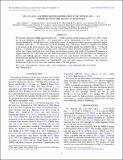| dc.contributor.author | Chiti, Anirudh | |
| dc.contributor.author | Placco, Vinicius M. | |
| dc.contributor.author | Frebel, Anna L. | |
| dc.contributor.author | Ji, Alexander Pung | |
| dc.contributor.author | Jacobson, Heather | |
| dc.date.accessioned | 2015-11-24T21:09:49Z | |
| dc.date.available | 2015-11-24T21:09:49Z | |
| dc.date.issued | 2015-09 | |
| dc.date.submitted | 2015-06 | |
| dc.identifier.issn | 2041-8213 | |
| dc.identifier.issn | 2041-8205 | |
| dc.identifier.uri | http://hdl.handle.net/1721.1/100051 | |
| dc.description.abstract | We present a Magellan/MIKE high-resolution (R ~ 35,000) spectrum of the ancient star SD 1313−0019, which has an iron abundance of [Fe/H] = -5.0, paired with a carbon enhancement of [C/Fe] ~ 3.0. The star was initially identified by Allende Prieto et al. in the BOSS survey. Its medium-resolution spectrum suggested a higher metallicity of [Fe/H] = -4.3 due to the Ca ii K line blending with a CH feature, which is a common issue related to the search for the most iron-poor stars. This star joins several other similar stars with [Fe/H] ≲ -5.0 that all display a combination of low-iron and high-carbon abundances. Other elemental abundances of SD 1313−0019 follow that of more metal-rich halo stars. Fitting the abundance pattern with yields of Population III supernovae suggests that SD 1313−0019 had only one massive progenitor star with 20-30 M[subscript ʘ] that must have undergone a mixing and fallback episode. Overall, there are now five stars known with [Fe/H] ≲ -5.0 (1D local thermodynamic equilibrium abundances). This ever-increasing population of carbon-rich, iron-deficient stars can potentially constrain nucleosynthesis in Population III stars and their supernova explosions, the formation mechanisms of the first low-mass stars, and the nature of the first galaxies. | en_US |
| dc.description.sponsorship | National Science Foundation (U.S.) (CAREER Grant AST-1255160) | en_US |
| dc.description.sponsorship | National Science Foundation (U.S.) (PHY 08-22648) | en_US |
| dc.description.sponsorship | National Science Foundation (U.S.). Physics Frontier Center/Joint Institute for Nuclear Astrophysics (PHY 14-30152) | en_US |
| dc.description.sponsorship | National Science Foundation (U.S.). Physics Frontier Center/JINA Center for the Evolution of the Elements | en_US |
| dc.language.iso | en_US | |
| dc.publisher | IOP Publishing | en_US |
| dc.relation.isversionof | http://dx.doi.org/10.1088/2041-8205/810/2/L27 | en_US |
| dc.rights | Article is made available in accordance with the publisher's policy and may be subject to US copyright law. Please refer to the publisher's site for terms of use. | en_US |
| dc.source | IOP Publishing | en_US |
| dc.title | SD 1313–0019: ANOTHER SECOND-GENERATION STAR WITH [Fe/H] = −5.0, OBSERVED WITH THE MAGELLAN TELESCOPE | en_US |
| dc.type | Article | en_US |
| dc.identifier.citation | Frebel, Anna, Anirudh Chiti, Alexander P. Ji, Heather R. Jacobson, and Vinicius M. Placco. “SD 1313–0019: ANOTHER SECOND-GENERATION STAR WITH [Fe/H] = −5.0, OBSERVED WITH THE MAGELLAN TELESCOPE.” The Astrophysical Journal 810, no. 2 (September 9, 2015): L27. © 2015 The American Astronomical Society | en_US |
| dc.contributor.department | Massachusetts Institute of Technology. Department of Physics | en_US |
| dc.contributor.department | MIT Kavli Institute for Astrophysics and Space Research | en_US |
| dc.contributor.mitauthor | Frebel, Anna L. | en_US |
| dc.contributor.mitauthor | Chiti, Anirudh | en_US |
| dc.contributor.mitauthor | Ji, Alexander Pung | en_US |
| dc.contributor.mitauthor | Jacobson, Heather R. | en_US |
| dc.relation.journal | The Astrophysical Journal. Letters | en_US |
| dc.eprint.version | Final published version | en_US |
| dc.type.uri | http://purl.org/eprint/type/JournalArticle | en_US |
| eprint.status | http://purl.org/eprint/status/PeerReviewed | en_US |
| dspace.orderedauthors | Frebel, Anna; Chiti, Anirudh; Ji, Alexander P.; Jacobson, Heather R.; Placco, Vinicius M. | en_US |
| dc.identifier.orcid | https://orcid.org/0000-0002-7155-679X | |
| dc.identifier.orcid | https://orcid.org/0000-0001-7727-1640 | |
| dc.identifier.orcid | https://orcid.org/0000-0002-4863-8842 | |
| dc.identifier.orcid | https://orcid.org/0000-0002-2139-7145 | |
| mit.license | PUBLISHER_POLICY | en_US |
| mit.metadata.status | Complete | |
